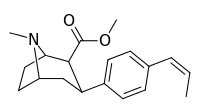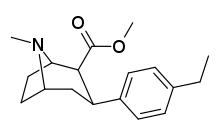RTI-83
RTI-83 ((–)-2β-carbomethoxy-3β-(4-ethylphenyl)tropane) is a phenyltropane derivative which represents a rare example of an SDRI or serotonin-dopamine reuptake inhibitor, a drug which inhibits the reuptake of the neurotransmitters serotonin and dopamine, while having little or no effect on the reuptake of the related neurotransmitter noradrenaline. With a binding affinity (Ki) of 55 nM at DAT and 28.4 nM at SERT but only 4030 nM at NET, RTI-83 has reasonable selectivity for DAT/SERT over NET

 | |
| Clinical data | |
|---|---|
| Other names | RTI-4229-83 |
| Identifiers | |
| |
| CAS Number | |
| PubChem CID | |
| ChemSpider | |
| UNII | |
| ChEMBL | |
| CompTox Dashboard (EPA) | |
| Chemical and physical data | |
| Formula | C18H25NO2 |
| Molar mass | 287.403 g·mol−1 |
| 3D model (JSmol) | |
| |
| |
However, further research has shown that by extending the ethyl chain even better selectivity can be achieved, with the 4′-(cis-propenyl) analogue having Ki values of 15 nM at DAT and 7.1 nM at SERT, vs 2800 nM at NET.[1][2] However RTI-436 has an even better selectivity for DAT over NET (3.09nM @ DAT & 1,960nM @ NET or a NET/DAT ratio of 634.3, but with lesser DAT/SERT equivalent potency with a ratio between them of 108) and RTI-88 has a still better ratio (984 NET/DAT with additionally having less selectivity than the former compound between DAT/SERT and having a more even spread of potency with the ratio between DAT & SERT being 88)
| Compound | DAT
[3H]WIN 35428 |
5-HTT
[3H]Paroxetine |
NET
[3H]Nisoxetine |
Selectivity
5-HTT/DAT |
Selectivity
NET/DAT | |||
|---|---|---|---|---|---|---|---|---|
| RTI-83 | 55 ± 2.1 | 28.4 ± 3.8 | 4,030 ± 381 | 0.5 | 73.3 | |||
| RTI-102 | 474 | 1928 | 43,400 | 4.06 | 91.5 | |||
| RTI-304 | 15 ± 1.2 | 7.1 ± 0.71 | 2,800 ± 300 | 0.5 | 186.6 | |||
| RTI-88 | 1.35 ± 0.11 | 120 ± 4 | 1,329 ± 124 | 88.9 | 984.0 | |||
| 83a* ‡ | 1.20 ± 0.29 | 48.7 ± 8.4 | 10,000.0 | 40.6 | 8,333.3 | |||
| RTI-143 | 4.06 ± 0.22 | 404 ± 56 | 40,270 ± 180 | 99.5 | 9,919.0 | |||
| *C3β-Ph-para=iodo, C2β-R=CO2-i-Pr, N8=CH2CH2CH2F ‡Compound code for phenyltropane in accord with Singh's "Chemistry, Design & SAR of cocaine antagonists" paper nomenclature, of no relation to RTI naming convention despite similarity to namesake of drug on topic.[3] | ||||||||
Such drugs are speculated to be useful as potential antidepressants, but few examples have been reported in the literature as yet. However, while RTI-83 has been used for binding studies to model the monoamine transporter proteins,[4] its pharmacology in vivo has not been studied in detail.
References
- Blough BE, Abraham P, Lewin AH, Kuhar MJ, Boja JW, Carroll FI (September 1996). "Synthesis and transporter binding properties of 3 beta-(4'-alkyl-, 4'-alkenyl-, and 4'-alkynylphenyl)nortropane-2 beta-carboxylic acid methyl esters: serotonin transporter selective analogs". Journal of Medicinal Chemistry. 39 (20): 4027–35. doi:10.1021/jm960409s. PMID 8831768.
- Singh S (March 2000). "Chemistry, design, and structure-activity relationship of cocaine antagonists". Chemical Reviews. 100 (3): 925–1024. doi:10.1021/cr9700538. PMID 11749256.
- Singh S (2010). "Chem Inform Abstract: Chemistry, Design, and Structure-Activity Relationship of Cocaine Antagonists". ChemInform. 31 (20): no. doi:10.1002/chin.200020238.
- Roman DL, Saldaña SN, Nichols DE, Carroll FI, Barker EL (February 2004). "Distinct molecular recognition of psychostimulants by human and Drosophila serotonin transporters". The Journal of Pharmacology and Experimental Therapeutics. 308 (2): 679–87. doi:10.1124/jpet.103.057836. PMID 14593087. S2CID 6439942.
External links
- Jin C, Navarro HA, Carroll FI (December 2008). "Development of 3-phenyltropane analogues with high affinity for the dopamine and serotonin transporters and low affinity for the norepinephrine transporter". Journal of Medicinal Chemistry. 51 (24): 8048–56. doi:10.1021/jm801162z. PMC 2841478. PMID 19053748.